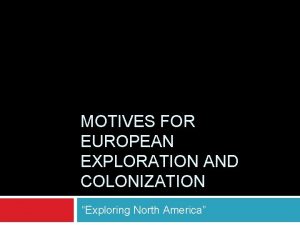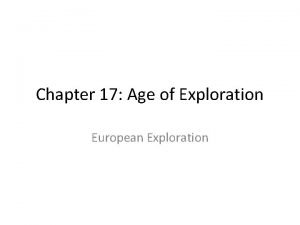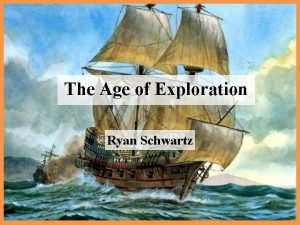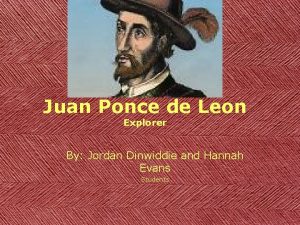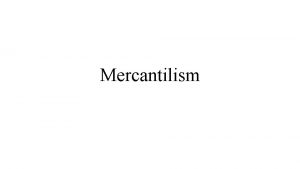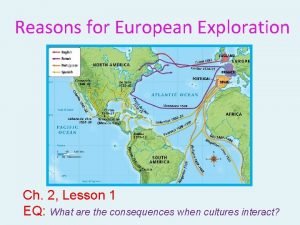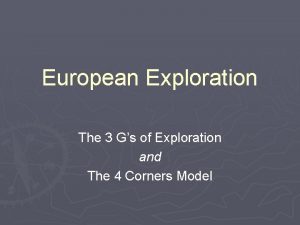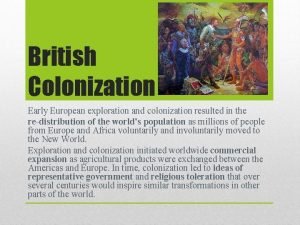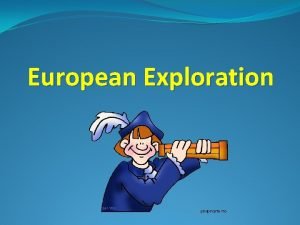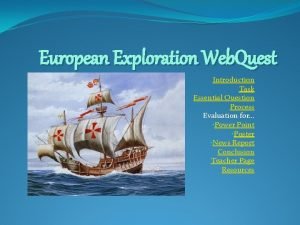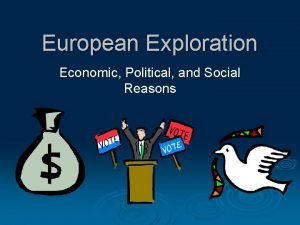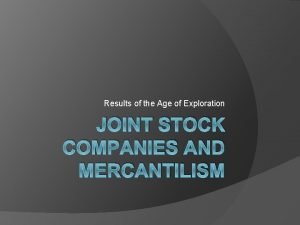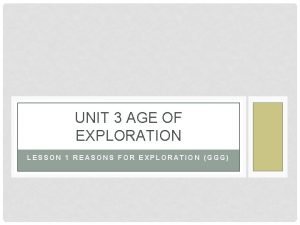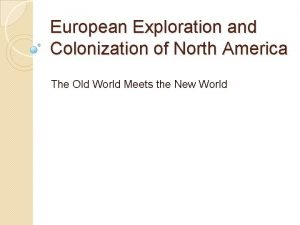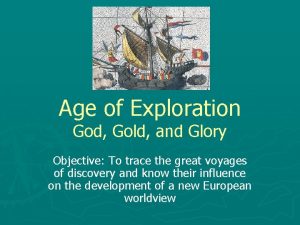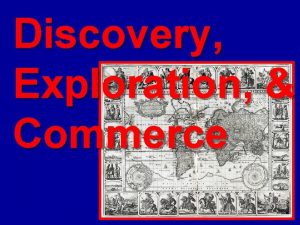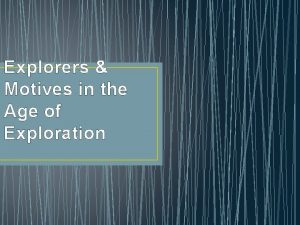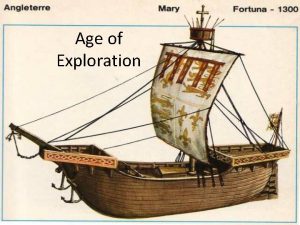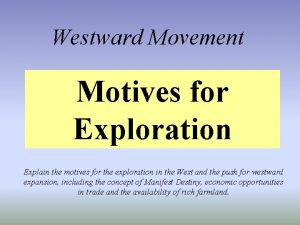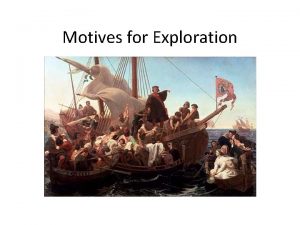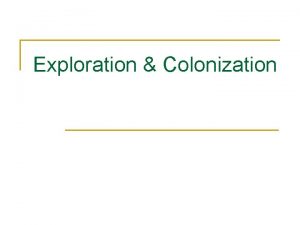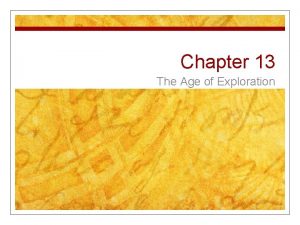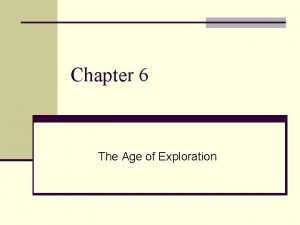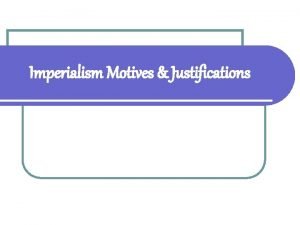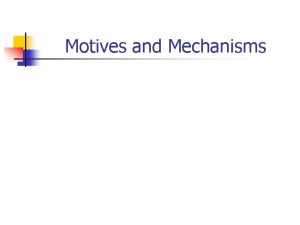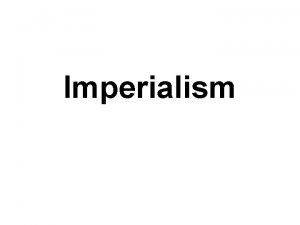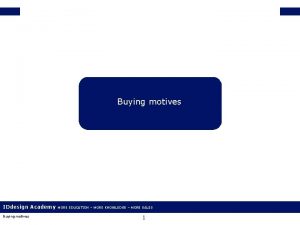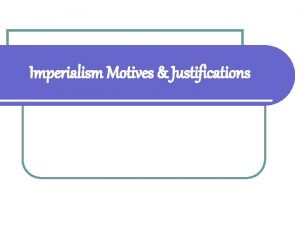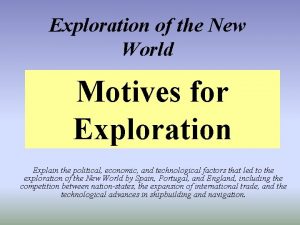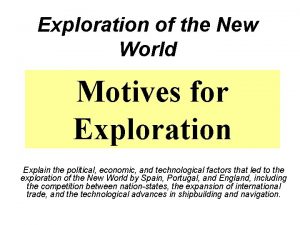Chapter 17 Age of Exploration European Exploration Motives






















- Slides: 22

Chapter 17: Age of Exploration European Exploration

Motives for Exploration • Economic Expansion – Increased Trading • Need for Asian spices – Used for taste and as preservatives • Desire for precious metals – Rumors of large amount of gold • Religious zeal – Conversion of indigenous people – “Gold, glory, and God”

Means of Exploration • Advancements to travel – Caravel • Smaller faster Portuguese ship • Able to carry large cargo – Triangular sails • Used to sail against the wind – Astrolabe (Greek) • Travel by the stars – Magnetic Compass (Chinese)

Portuguese Exploration • Prince Henry the Navigator – Set up a school for sailing • Travelled along coast of Africa – Found gold • 1488: Batholomeu Diaz – Sailed around Cape of Good Hope • 1498: Vasco De Gama – Sailed around Cape and to India – Admiral Albuquerbue eventually took control of spice trade from Muslims

Spanish Explorers • Looked for route to Asia across Atlantic Ocean • 1492: Christopher Columbus – Hit Caribbean thinking it was India – Travelled back 3 more times • 1500: Ferdinand Magellan – First to travel around world – However he died in Philippines – Still given title

New Lands to Explore • Treaty of Tordesillas (1494) – Boundary line drawn for unexplored territory – Portugal is given right to explore all things east of the line, which includes Africa – Spain given right to explore all things west of line, which includes Americas • John Cabot – Sailed for England – 1497: Explored New England Coast

Treaty of Tordesillas

Spanish Empire • Conquest of the Aztecs 1519: Led by Hernan Cortes Attacked the capital of Tenochtitlan (Mexico City) Started with small number of men Convinced local tribes to join him as they did not like the oppressive rule of the Aztecs – 1520: Cortes takes Montezuma hostage – Aztecs eventually revolt – –

Spanish Empire • Fall of the Aztecs – Disease • Aztecs were not used to European diseases • Smallpox devastated the Aztecs • More soldiers reinforced the Spaniards daily – – After 4 months, the Aztecs surrendered Spanish leveled all signs of Aztecs Built new churches and roads Led to control of all Mexico

Spanish Empire • Conquest of Incas – – – Francisco Pizarro (1531) Similar to what we saw with Aztecs Small number of soldiers Used superior weapons to scare Incas Disease would ravage population 1535: Took control of entire Incan Empire with Lima as major colony

European Rivals • The Dutch – Established West India Company • Struggled early to maintain any power – Established New Netherland in America • Held a large fur trading outpost • Eventually taken over by English • The English – Controlled most of eastern seaboard of America – Miniscule compared to the Spanish Empire • The French – Controlled most of present-day Canada – Established a colony in New Orleans

Chapter 17: Age of Exploration First Global Economic Systems

What is Mercantilism? • Mercantilism – – – Prosperity based on gold and silver Favorable balance of trade Export more than you import Developed out of established trading posts Gov’t willing to subsidize new industries – Taxes placed on imported goods – Expansion of transportation

Columbian Exchange • Exchange of plants and animals between Europe and Americas

Pros and Cons of Columbian Exchange • Pros – Increased economic activity in both Europe and America – Increased population and food production – Created new markets • Cons – Disease • Smallpox • 1492 -1538: Hispanola pop. went from 250, 000 to 500 • 1500 -1630: Mexico pop. went from 25 million to 1 million

Atlantic Slave Trade • Triangular Trade – Trading route between Europe, Africa, and America – Europe had finished goods; Africa had slaves; America had raw materials

Where in Africa did Slaves come from? • In beginning, they were POW’s from African warfare • Slaves were found on the coastline of west Africa • As slave trade increased, traders moved farther inland • Effects of Atlantic Slave Trade – – Depopulated Africa Increased warfare in Africa Destruction of societies Abolished by French in 1790’s, UK 1833, US 1860’s

Regions of the Slave Trade

Chapter 17: The Age of Exploration Colonial Latin America

Colonial Empires in Latin America • Social Classes of Latin America – Peninsulares • Spanish and Portuguese officials born in Europe • Held all governmental positions Creoles • People born in Latin America but of European descent • Treated as second class citizen

• Social Classes of Latin America – Mestizos • Offspring of intermarriage between Native Americans and Euros – Mulattoes • Offspring of intermarriage between Africans and Europeans – Both Mestizos and Mulattoes considered inferior by Europeans – Kept them confined to menial jobs and rarely becoming more than a merchant early on

Economic Foundations • How did the Spanish and Portuguese prosper? – 1. Mining • Gold and silver mines • Natural Resource Extraction – 2. Farming • Farmed single crops for profit • Led to deforestation of areas – 3. Encomienda System • Labor system • Natives had to pay taxes and provide labor • Led to major declines in native populations – 4. Trade • Precious metals and also local crops and spices
 Roanoke island mystery
Roanoke island mystery Chapter 17 the age of exploration
Chapter 17 the age of exploration Vasco nunez de balboa motives for exploration
Vasco nunez de balboa motives for exploration Ponce de leon motives for exploration
Ponce de leon motives for exploration Juan ponce de leon impact
Juan ponce de leon impact Iron age bronze age stone age timeline
Iron age bronze age stone age timeline Iron age bronze age stone age timeline
Iron age bronze age stone age timeline Chapter 19 an age of exploration and isolation
Chapter 19 an age of exploration and isolation What factors encouraged european exploration
What factors encouraged european exploration European exploration map
European exploration map 3 gs of exploration
3 gs of exploration Early european exploration and colonization resulted in -
Early european exploration and colonization resulted in - 3 g's of european exploration
3 g's of european exploration European exploration webquest
European exploration webquest European exploration economic reasons
European exploration economic reasons Joint stock company age of exploration
Joint stock company age of exploration Ggg
Ggg Age of exploration chart
Age of exploration chart Age of exploration videos
Age of exploration videos Heroic age of antarctic exploration
Heroic age of antarctic exploration Jacques cartier legacy
Jacques cartier legacy God gold and glory
God gold and glory Pineda explorer route
Pineda explorer route
